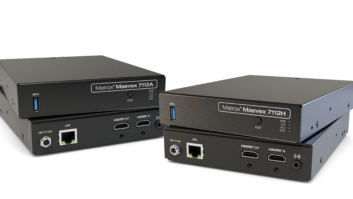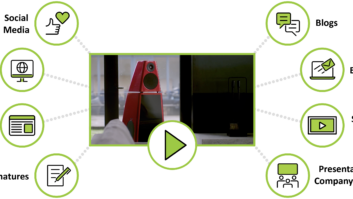Digital media servers have become one of the fastest growing product categories in the home networking market. According to a Parks Associates study completed this year, media server platforms (including personal video recorders, Media PCs and non-PC based servers) are expected to increase from six million units shipped in 2004 to 24 millions units projected in 2008.
Over the past several years the residential market has seen a number of hard drive-based audio server platforms emerge from companies such as Request Multimedia, Escient, Elan and Lansonic (to name just a few). Only in the last two years have we begun to see the entry of hard drive-based video servers. Companies such as AMX, Kaleidescape and Xperinet, have launched products over the past year that stream digital video throughout the home in a manner similar to that of their audio server predecessors.
The challenge for todays custom electronics integrator is to understand how these new video server products compare to each other in architecture, installation and end-user experience. In this article we will review these product characteristics for the dominant video server products in the market today, specifically the:
MAX Multi-Media Server (MMS) System
Kaleidescape System
Xperinet Multiple Independent Relay Video (MIRV) System
Request Multimedia Video Request System
These manufacturers and products were selected because they all have video server-based products that are currently available and shipping. Several other manufacturers were considered for this review but their product was not ready for the sales channel by the August 31, 2004 deadline that was set for this report. We reviewed the video server product lines of these companies in the following categories:
Product Overview and System Architecture
Product History and Positioning
Server and DVD Reader
Client Platforms
Control Platforms
Network Diagrams
Product Experience: Installation, Configuration, and Operation
Legal Compliance
Retail Price Comparison Scenarios
The information compiled and assimilated in this article was gathered over the period of June 1 to August 31, 2004. Each reviewed product was installed and tested at cyberManors headquarters in Los Gatos, California, with the direct sales and technical support of each manufacturer.
It is important to note that the video server market is very young and dynamic. The results in this study are primarily based upon actual results from shipping and tested products as of August 31, 2004. Although all of these companies plan future upgrades to their product lines, these features and benefits are not included in this report because they could not be evaluated in our test lab over the time frame of our study.
AMXs MAX Multi-Media Server (MMS) System: AMX has been shipping their MAX multi-media server (MMS) since December 2003. Known primarily for its home control products aimed at affluent households and corporate customers, AMX expanded into multi-media server products in September, 2003, when it acquired a company called Media Access Solutions.
In June of 2004 they announced several hardware and software enhancements to this product line and are just beginning to ship these products. In our testing we were able to evaluate both the older server and the newer hardware/software platforms. Because the older units are now discontinued (except for the MMS-900) and replaced by these new platforms, this review will focus on the newer MMS models.
AMX plans to market this product to both the residential and commercial segments. The company recognizes that most homes will probably not require up to 25 simultaneous audio/video distribution zones so this feature has been primarily developed to support their commercial distribution strategy.
It must be pointed out, however, that current motion picture copyright laws prohibit the use of these video servers in a commercial environment so the market for them will be for commercial accounts that have developed their own video content for multi-zone distribution.
The Review: The MAX MMS system was the most complex system of the four tested video servers to set up. Our test configuration included the MAX MMS server, a Modero touch-screen, two audio/video modules (AVMs) and the Netlinx control unit. The Modero unit initially had trouble properly connecting to the server until the network speed setting was changed from Auto to 10MB Full Duplex. We also noticed that the MMS server must boot completely before the AVM stations can properly boot-up, a process that can take up to four minutes. In the event that a power outage exceeds the back-up time provided by an uninterruptible power supply connected to the MMS server, a staged power-up scheme must be developed by the integrator to ensure proper operation of the MMS system.
Another limitation is that movies cannot be watched in any of the movie zones while a DVD is being imaged to the servers hard-drive. The process must be completed before any movie can be watched in one of the movie zones.
Configuration of the AMX system is completed via the Modero touchscreen display panels. There are two levels of configuration. The first level permits general set up of video settings, touch panel information, panel volume and time and project information. The second level is password protected and is used for password set-up, touchpanel calibration, sensor setup and IP connection information.
AMX has significantly improved the end-user and integrator experience with its second release of the MMS server product line. Control of movies from the Modero panel in the first product release involved a complex series of touch-screen commands on several different GUI screens with sparse movie content information. The newer MMS software provides a much richer Modero graphical user interface that is easier to navigate and control. The new software also supports movie cover art and preview capabilities.
AMX also supports integrator server and AVM client set-up parameters for movie video and audio controls but these must be done from a Linux text-based monitor connected to the VGA port of the MMS server. The end-user can also maintain, update and monitor their movie collection with the AMX WinMAX software application on their computer.
Kaleidescape System: Kaleidescape has been shipping its movie server, DVD reader and movie players since August 2003. They have kept the current hardware architecture over the course of the last year with the exception that they have increased their hot-swappable drive capacities from 250GB to 300GB. Over the course of the last year, however, they have made several significant software enhancements to the product that have included the ability to add personal videos and significant installer and end-user control enhancements.
Kaleidescape has targeted this product to be sold exclusively to the high-end residential community. The focus of the company since its inception has been to sell and support a reliable, legally compliant video server appliance that is easy to install, control, update and service.
The Review: Installation of the Kaleidescape system was straight forward and trouble free. The DVD storage server required only power and 100Base-T ethernet connections, as does the separate DVD reader. Because the server and reader do not have any audio/video ports they do not need to be located in close proximity to a media zone.
These components can be placed where they are most convenient, anywhere on the wired ethernet network in the home. The separate Movie Player should be located in a media area where audio/video connections can drive a local display and sound system (unless they are used as source content to a centrally located audio/video switcher). Screen calibration was accomplished with Kaleidescapes on-screen calibration software. The server requires just under a minute and a half to boot and the players discover the host server without any end-user intervention.
Software configuration of the Kaleidescape system is accomplished from two different sections of the web utility. The Installer section allows for configuration of the components by the custom electronics integrator. There are default initial settings but you can rename components, set static IP information and change other A/V settings to fit your custom requirements. The User section allows the homeowner to view and configure the day-to-day functions of the server such as system status, movie library information, and parental control settings. There are also links to a browser-based control screen for each movie player in three different size formats. These graphical screens can be easily accessed from a Java control panel generated by the Kaleidescape server when any web browser in the home is pointed to: http://my-kaleidescape.
Kaleidescape offers the richest set of graphically friendly controls of all the video servers in this test on the greatest variety of platforms. Some of the key elements of control that enrich the end-user experience include:
High-resolution DVD cover art screen that showcases of up to 24 DVD cover jackets on one screen (see screenshots below)
Easy-to-navigate and search capabilities by movie title, artist, ratings, etc.
Book-marking that allows you to easily pause a movie in one room and start viewing it again from another room.
Xperinets Multiple Independent Relay Video (MIRV) System: Xperinet recently began shipping its MIRV (Multiple Independent Relay Video) line of video servers in the summer of 2004. The company has five different product models, the Tomahawk, Polaris, Trident, Poseidon and the Titan. These servers are differentiated by their hard drive capacities (from one to three terabytes) and the number of simultaneous, independent stations that they can support (from three to six stations).
Xperinet has targeted the residential market as its primary customer base for this product. Complementing its line of video server products, Xperinet has also developed a line of Windows- and Linux-based computer telephony products.
The Review: Installing the Xperinet system was relatively straightforward. We received documentation that walked us through an easy setup of the evaluated Tomahawk server and a Taurus client. Both units were controlled by a wireless keyboard/mouse and connected across a 100BaseT Ethernet switch.
Because there are Xperinet specific audio and video ports installed on both the server and the client (in addition to standard computer-type audio/video ports) one needs to take care to make connections to the correct ports and specify in the setup configuration exactly which port and signal quality of signal that you are sending from the server or the client. These settings are clearly covered in the documentation we received.
The server takes a little over two minutes to boot before the main start-up screen appears. The client takes a little less than two minutes before its main control menu page appears and, like the AMX system, should be started after the server is up and running. If the client cannot find the server for any reason, a window opens up on the client asking for the servers IP address. Once this IP address is properly entered, the Taurus client will properly connect to the server.
Unlike the AMX MMS which cannot display movies during a DVD imaging process, the Xperinet Taurus client can run a movie during this process but the movie video can show signs of signal interference during this DVD download process. This interference may be mitigated with Xperinets introduction of its rackmount, gigabit-based X-1147 Taurus clienta product we did not get an opportunity to test.
Configuration of the server or the client is completed via the on-screen displays Setup navigational button with a wireless keyboard/mouse. Navigation of the servers various settings is very straight forward, allowing you to configure A/V output, DVD loading settings, passwords for library editing, parental control and IP system configuration. The onscreen Taurus client interface allows you to search for movies by title, actor, genre, writer, director, rating and year. Cover art and movie descriptions also are available onscreen.
Request Multimedias Video ReQuest System: ReQuest Multimedia has been shipping the Video ReQuest DVD jukebox controller since the middle of this year. Unlike the hard drive-based products from AMX, Kaleidescape and Xperinet, the Video ReQuest controller is not a digital video server but a controller that retrieves and directs video content from a Sony DVP-CX777ES 400 Disc DVD changer. One controller can support and manage up to four of these Sony players, allowing the Video ReQuest to control up to 1,600 DVDs.
The Video ReQuest controller can only control the audio/video output of the Sony DVD changer to a single media zone. If the end-user wants to distribute the DVD content to another zone then another Video Request controller and Sony DVD changer must be purchased and installed.
ReQuest Multimedia was founded in 1998 to develop a line of products dedicated to the storage and retrieval of digital multimedia. ReQuest Multimedia manufactures the Video ReQuest controller. Unlike its audio-based products which are all stored on digital servers, the Video ReQuest does not incorporate disk-based technology in this product line.
The Review: We tested the Video ReQuest (VRQ) controller with the Sony 400 Disc DVD changer, two monitors and its IR remote, and it worked well. A more optimal configuration would have been to test the VRQ with a video switcher in line to the display, because there are two separate video feeds required to use this system. The first video feed is from the VRQ displaying the control pages for movie selection, etc. while the second video feed is for the DVD changers A/V outputs which provides the movie content to the display.
The VRQ controls the changer and is connected via an RS-232 serial cable from one of the four serial ports on the VRQ to the serial port on the changer. The VRQ, along with its companion DVD changer(s) and video switcher(s) need to reside in the media area.
Because the Video ReQuest is a DVD jukebox-based platform, movies take longer to load than the digital server based products reviewed in this paper. In our test it took about 30 seconds to move from one movie selection to another selection, while this only required a few seconds for the digital server-based products.
Configuration of the VRQ is done with the on-screen display using the supplied IR remote control. There are configuration options for audio and video outputs, network settings, system information and status. The IR remote control also allows the end user to select from a movie list, genres, ratings, actors or directors. Once a movie is selected the onscreen information appears without cover art. If cover art is desired the end user (or integrator) must locate it and then drag and drop the image to the Video ReQuest controller.
So Who Wins? Summarizing the results of our video server evaluation is challenging. Each of the four products that we tested have strengths and weaknesses relative to one another. Compounding the evaluation difficulty is that each manufacturers product is in a state of steady evolution as they quickly respond to customer demands for additional functionality. It is, therefore, impossible to declare a definitive winner from this evaluation but one can clearly summarize the strengths of each of these respective products and define the residential environment in which they are best suited.
The enhanced MAX MMS server by AMX is a significant improvement over their first release of their product earlier in the year in both hardware and software features. AMXs core strength is in their unified home automation control and hardware products, exemplified by the elegant Modero touchscreen panels.
Although the MMS server can work as a stand-alone product independent of the need for Modero touchscreen panel and a NetLinx controller, it is quickly obvious that this is not the best scenario in which to deploy this product, because the controls are much more robust and engaging when using the Modero panel over the simpler onscreen display controlled by a wireless keyboard and mouse. AMX is also the only video server product offering digital audio as well as video distribution, although it is very likely that we will see Kaleidescape and Xperinet offer this same functionality in the near future.
In general, AMX was one of the more costly of the media servers studied in this evaluation even before adding the expense of Modero panels and a NetLinx controller. But, if you want to distribute to multiple zones, then this product is cheaper than its competition. Nonetheless, it is probably best suited for homes that already have an AMX home automation solution or are considering the purchase of one since it extends and enhances the AMX platform of integrated home controlled products.
One cant help but be impressed by the Kaleidescape product line. From its physical appearance and design to its software interface, everything about the product looks and runs first class. Designed as a video-serving appliance from the ground up, Kaleidescape incorporates its own server operating system coupled with hardware components and chipsets specifically chosen to deliver an optimal video serving and viewing experience. Of the video servers that we tested, it was clearly the easiest to set up and control. It also had, by far, the most versatile and elegant suite of software controls and platforms from which to operate these controls.
Over the course of testing their products, Kaleidescape released several online firmware upgrades to further enhance the functionality of their video serverone of these enhancements included the ability to import and playback personal DVD recordings as well as movies. Kaleidescape, having been in the video server market longer than its competitors clearly has a more refined and mature product based on their experience and the feedback they have received from existing customers.
The drawback to the Kaleidescape system is that they currently only support video distribution. Digital distribution of whole-house audio must be accomplished by choosing another manufacturer with its own unique, distinct set of software/hardware products. Kaleidescape recognizes this shortcoming and plans to add audio serving capabilities to their server in the near future. The other concern with the Kaleidescape is its high cost. Although it is certainly competitive with AMX, it is definitely more expensive than Xperinet or the Video ReQuest single-zone solution and will be at the high end of video server price point (most noticeable as other video serving products enter the market later this year and next year). But make no mistake, Kaleidescape is the Mercedes Benz of the digital video server worldonce youve tried one its hard not to want one!
Xperinet entered the video server with a desire to offer a very rich set of features at an affordable price point. With this summers introduction of their video server line of products they have done an admirable job of accomplishing this goal.
Xperinet appears to have used commercially available hardware cases, chipsets and add-in boards, coupled this hardware with the Linux operating system software and developed a fairly robust, easy-to-use, digital video distribution system. The fact that they have added a video capture card in their server is an indication that this box will distribute more than just imaged DVDs (and digital audio in the near future as well) but VHS, satellite or cable TV recorded content. This would be the trifecta of digital audio/video servers when they accomplish this task since every end-user would ideally like one box to control for their whole-house streaming distribution of movie, audio, and recorded television content (ideally in high-definition video, but standard definition is a good start).
Xperinets drawbacks are that its licensing compliance for DVD movie encryption is weak. Xperinet places this compliance on the shoulders of the customer by asking them to install a third-party decryption software program to enable the imaging of DVDs onto their server. If the company also seeks to add cable or satellite video distribution from their video server it is a weakness that will need to be addressed.
Video ReQuest is a controller of a DVD jukebox. Video ReQuests strength is that it is far and away the most affordable manner in which to store and playback a very large DVD library in one zone of the house. For many budget-conscious customers this may be the perfect solution to manage and playback their large DVD library. Also, because the video request does not image the DVD disk to a hard drive they navigate clear of many of the potential licensing issues faced by other manufacturers in this product category.
While the Video ReQuest controller can manage and serve a large collection of DVDs (up to 1600 with four jukeboxs) its drawback is that it is currently limited to showing these DVDs in only one zone. Not surprisingly, there is also a latency associated with the retrieval and playback of a DVD (about 30 seconds) not found in the digital video servers evaluated in this study. Also their own current movie control software is somewhat primitive in comparison to the other products studied in this article,although this graphical user interface is improved when the more costly Crestron hardware and software is used to control the unit.
All of these products are the beginning of a new wave of digital serving platforms that will enter the U.S. home over the next several decades. We have already seen the phenomenal acceptance of digitally stored music with the success of the Apple iPod and digitally stored television with the success of TiVO. It is now logical to assume that all of this encoded audio and video will need to stream to anywhere inside and outside the home where the homeowner wants to enjoy their purchased entertainment content.
The products evaluated in this study are at the forefront of video digital whole house server/client distributed entertainment solutions. The authors of this article applaud their efforts in driving open standards based home networking technology to a level that adds rich, easily controllable audio/video entertainment to every room in the home.
Gordon van Zuiden and Jim Kohl work for cyberManor, in Los Gatos, California.







